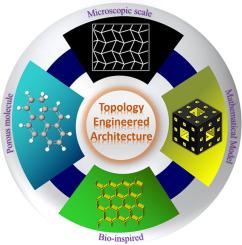Materials Today ( IF 21.1 ) Pub Date : 2021-07-05 , DOI: 10.1016/j.mattod.2021.03.014 Rushikesh S. Ambekar 1 , Brijesh Kushwaha 1 , Pradeep Sharma 2 , Federico Bosia 3 , Massimiliano Fraldi 4 , Nicola M. Pugno 5, 6 , Chandra S. Tiwary 1

|
Materials that are lightweight yet exhibit superior mechanical properties are of compelling importance for several technological applications that range from aircrafts to household appliances. Lightweight materials allow energy saving and reduce the amount of resources required for manufacturing. Researchers have expended significant efforts in the quest for such materials, which require new concepts in both tailoring material microstructure as well as structural design. Architectured materials, which take advantage of new engineering paradigms, have recently emerged as an exciting avenue to create bespoke combinations of desired macroscopic material responses. In some instances, rather unique structures have emerged from advanced geometrical concepts (e.g. gyroids, menger cubes, or origami/kirigami-based structures), while in others innovation has emerged from mimicking nature in bio-inspired materials (e.g. honeycomb structures, nacre, fish scales etc.). Beyond design, additive manufacturing has enabled the facile fabrication of complex geometrical and bio-inspired architectures, using computer aided design models. The combination of simulations and experiments on these structures has led to an enhancement of mechanical properties, including strength, stiffness and toughness. In this review, we provide a perspective on topologically engineered architectured materials that exhibit optimal mechanical behaviour and can be readily printed using additive manufacturing.
中文翻译:

具有卓越机械强度的拓扑工程 3D 打印架构
重量轻但具有卓越机械性能的材料对于从飞机到家用电器的多种技术应用具有非常重要的意义。轻质材料可以节省能源并减少制造所需的资源量。研究人员在寻求这种材料方面付出了巨大的努力,这需要在剪裁材料微观结构和结构设计方面都有新的概念。利用新工程范式的建筑材料最近已成为创建所需宏观材料响应的定制组合的令人兴奋的途径。在某些情况下,从先进的几何概念中出现了相当独特的结构(例如陀螺仪、门格立方体或基于折纸/剪纸的结构),而在其他一些创新中,则是在仿生材料(如蜂窝结构、珍珠层、鱼鳞等)中模仿自然而出现的。除了设计之外,增材制造还可以使用计算机辅助设计模型轻松制造复杂的几何和仿生建筑。对这些结构的模拟和实验相结合,提高了机械性能,包括强度、刚度和韧性。在这篇综述中,我们提供了一个关于拓扑工程建筑材料的观点,这些材料表现出最佳的机械行为,并且可以使用增材制造轻松打印。增材制造能够使用计算机辅助设计模型轻松制造复杂的几何和仿生建筑。对这些结构的模拟和实验相结合,提高了机械性能,包括强度、刚度和韧性。在这篇综述中,我们提供了一个关于拓扑工程建筑材料的观点,这些材料表现出最佳的机械行为,并且可以使用增材制造轻松打印。增材制造能够使用计算机辅助设计模型轻松制造复杂的几何和仿生建筑。对这些结构的模拟和实验相结合,提高了机械性能,包括强度、刚度和韧性。在这篇综述中,我们提供了一个关于拓扑工程建筑材料的观点,这些材料表现出最佳的机械行为,并且可以使用增材制造轻松打印。











































 京公网安备 11010802027423号
京公网安备 11010802027423号